Trajectory Tracking Control of an Autonomous Underwater Vehicle Under Disturbance and Model Uncertainty
Abstract
1. Introduction
- A robust Model Predictive Control framework is designed for AUV trajectory tracking, which explicitly handles actuator saturation by constraining the maximum propeller driving force.
- Thruster rate-of-change constraints are novelly included within the same MPC formulation. This inclusion is critical for ensuring the control signals are physically achievable by the thrusters, preventing control chattering, and protecting hardware integrity.
- A set of practical hardware-level constraints (both force magnitude and rate-of-change) is holistically integrated with online-updated system state constraints to achieve robust autonomous obstacle avoidance.
2. Modeling of the AUV
3. Control Algorithm Design
3.1. Algorithm Formation
3.2. Conditions for Stability and Tuning Guidelines
- Sufficient Prediction HorizonThe horizon must be long enough for the controller to be predictive, rather than purely reactive. A horizon that is too short can lead to short-sighted control actions and may fail to find a feasible solution for obstacle avoidance. Conversely, a horizon that is too long provides smoother, more predictive control but at a prohibitive computational cost. The choice of was empirically determined to be long enough to provide smooth, predictive avoidance of the obstacles in the test scenarios in this work.
- Feasible Constraint SatisfactionA fundamental assumption for MPC stability is that the optimization problem (Equation (12)) remains persistently feasible at every time step. This means a solution satisfying all actuator, rate, and obstacle constraints must always exist. This is generally achievable if the reference trajectory is smooth and the obstacles are not arranged in a way that creates an inescapable trap.
- Bounded DisturbancesThe controller’s robustness, demonstrated in our ±35% uncertainty tests, relies on the assumption that all unmodeled dynamics and external disturbances are bounded.
- Cost Function TuningThe weights in the cost function (Equation (9)) are critical. As discussed, the 5:1 priority ratio in matrix Q ensures the controller prioritizes the primary mission objective (path/heading tracking) over the secondary objective (velocity tracking), which is essential for stable path-tracking behavior.
- Control HorizonThe control horizon was chosen as a trade-off, reducing the computational load of the optimization problem while still providing sufficient control flexibility.
- Q/R RatioThis ratio between the state cost (Q) and the input cost (R) is the primary tuning ’knob’ for performance. A high ratio (high Q, low R) prioritizes aggressive tracking accuracy (fast convergence) at the cost of higher energy consumption and control effort. A low ratio (increasing R) results in ’lazier,’ more energy-efficient control but may compromise robustness to disturbances. The 5:1 priority ratio in Q further refines this, prioritizing path-keeping over velocity-tracking.
- Rate-of-Change ConstraintThis is a hardware-protection parameter. Setting it too low (overly restrictive) will make the controller feel sluggish and may prevent it from reacting fast enough to avoid an obstacle. Setting it too high defeats its purpose and allows for aggressive, chattering signals. This value should be tuned based on the physical thruster’s dynamic specifications.
4. Control Performance Validation and Analysis
4.1. Algorithmic Validation
4.1.1. Parameter Settings
4.1.2. Simulation Results Under Ideal Conditions
4.1.3. Simulation Results Under Disturbances and Uncertainties
4.1.4. Simulation Results with Small Obstacles
4.2. Validation on a Physical Simulation Platform
4.3. Physical Experiment
5. Conclusions
Author Contributions
Funding
Data Availability Statement
Conflicts of Interest
References
- Li, D.; Du, L. Auv trajectory tracking models and control strategies: A review. J. Mar. Sci. Eng. 2021, 9, 1020. [Google Scholar] [CrossRef]
- Lei, M.; Li, Y.; Pang, S. Extended state observer-based composite-system control for trajectory tracking of underactuated AUVs. Appl. Ocean Res. 2021, 112, 102694. [Google Scholar] [CrossRef]
- Thanh, P.N.N.; Tam, P.M.; Anh, H.H.P. A new approach for three-dimensional trajectory tracking control of under-actuated AUVs with model uncertainties. Ocean Eng. 2021, 228, 108951. [Google Scholar] [CrossRef]
- Shen, C.; Shi, Y.; Buckham, B. Trajectory tracking control of an autonomous underwater vehicle using Lyapunov-based model predictive control. IEEE Trans. Ind. Electron. 2017, 65, 5796–5805. [Google Scholar] [CrossRef]
- Shojaei, K.; Arefi, M.M. On the neuro-adaptive feedback linearising control of underactuated autonomous underwater vehicles in three-dimensional space. IET Control Theory Appl. 2015, 9, 1264–1273. [Google Scholar] [CrossRef]
- Abdelaal, M.; Fränzle, M.; Hahn, A. Nonlinear Model Predictive Control for trajectory tracking and collision avoidance of underactuated vessels with disturbances. Ocean Eng. 2018, 160, 168–180. [Google Scholar] [CrossRef]
- Raffo, G.V.; Ortega, M.G.; Rubio, F.R. MPC with nonlinear H∞ control for path tracking of a quad-rotor helicopter. IFAC Proc. Vol. 2008, 41, 8564–8569. [Google Scholar] [CrossRef]
- Wu, G.X.; Ding, Y.; Tahsin, T.; Atilla, I. Adaptive neural network and extended state observer-based non-singular terminal sliding modetracking control for an underactuated USV with unknown uncertainties. Appl. Ocean Res. 2023, 135, 103560. [Google Scholar] [CrossRef]
- Li, J.; Xiang, X.; Dong, D.; Yang, S. Prescribed time observer based trajectory tracking control of autonomous underwater vehicle with tracking error constraints. Ocean Eng. 2023, 274, 114018. [Google Scholar] [CrossRef]
- Duan, K.; Fong, S.; Chen, C.P. Reinforcement learning based model-free optimized trajectory tracking strategy design for an AUV. Neurocomputing 2022, 469, 289–297. [Google Scholar] [CrossRef]
- Bingul, Z.; Gul, K. Intelligent-PID with PD feedforward trajectory tracking control of an autonomous underwater vehicle. Machines 2023, 11, 300. [Google Scholar] [CrossRef]
- Yao, Q. Fixed-time trajectory tracking control for unmanned surface vessels in the presence of model uncertainties and external disturbances. Int. J. Control 2022, 95, 1133–1143. [Google Scholar] [CrossRef]
- Wang, T.; Liu, Y.; Zhang, X. Extended state observer-based fixed-time trajectory tracking control of autonomous surface vessels with uncertainties and output constraints. ISA Trans. 2022, 128, 174–183. [Google Scholar] [CrossRef] [PubMed]
- Fan, Y.; Qiu, B.; Liu, L.; Yang, Y. Global fixed-time trajectory tracking control of underactuated USV based on fixed-time extended state observer. ISA Trans. 2023, 132, 267–277. [Google Scholar] [CrossRef]
- Batkovic, I.; Ali, M.; Falcone, P.; Zanon, M. Safe trajectory tracking in uncertain environments. IEEE Trans. Autom. Control 2022, 68, 4204–4217. [Google Scholar] [CrossRef]
- Chen, D.; Zhang, J.; Li, Z. A novel fixed-time trajectory tracking strategy of unmanned surface vessel based on the fractional sliding mode control method. Electronics 2022, 11, 726. [Google Scholar] [CrossRef]
- Bao, H.; Zhu, H. Modeling and trajectory tracking model predictive control novel method of AUV based on CFD data. Sensors 2022, 22, 4234. [Google Scholar] [CrossRef]
- Li, M.; Xie, W.; Wang, Y.; Hu, X. Prescribed performance trajectory tracking fault-tolerant control for dynamic positioning vessels under velocity constraints. Appl. Math. Comput. 2022, 431, 127348. [Google Scholar] [CrossRef]
- Wu, Z.; Wang, Q.; Huang, H. Adaptive neural networks trajectory tracking control for autonomous underwater helicopters with prescribed performance. Ocean Eng. 2022, 264, 112519. [Google Scholar] [CrossRef]
- Zhou, B.; Su, Y.; Huang, B.; Wang, W.; Zhang, E. Trajectory tracking control for autonomous underwater vehicles under quantized state feedback and ocean disturbances. Ocean Eng. 2022, 256, 111500. [Google Scholar] [CrossRef]
- He, L.; Xie, M.; Zhang, Y. A Review of Path Following, Trajectory Tracking, and Formation Control for Autonomous Underwater Vehicles. Drones 2025, 9, 286. [Google Scholar] [CrossRef]
- Liu, T.; Zhao, J.; Huang, J. A Gaussian-Process-Based Model Predictive Control Approach for Trajectory Tracking and Obstacle Avoidance in Autonomous Underwater Vehicles. J. Mar. Sci. Eng. 2024, 12, 676. [Google Scholar] [CrossRef]
- Li, J.; Xia, Y.; Xu, G.; Guo, Z.; Han, H.; Wu, Z.; Xu, K. Enhanced three-dimensional trajectory tracking control for AUVs in variable operating conditions using FMPC-FTTSMC. Ocean Eng. 2024, 310, 118805. [Google Scholar] [CrossRef]
- Li, B.; Gao, X.; Huang, H.; Yang, H. Improved adaptive twisting sliding mode control for trajectory tracking of an AUV subject to uncertainties. Ocean Eng. 2024, 297, 116204. [Google Scholar] [CrossRef]
- Hong, L.; Wang, X.; Zhang, D.; Xu, H. Numerical Study on Hydrodynamic Coefficient Estimation of an Underactuated Underwater Vehicle. J. Mar. Sci. Eng. 2022, 10, 1049. [Google Scholar] [CrossRef]
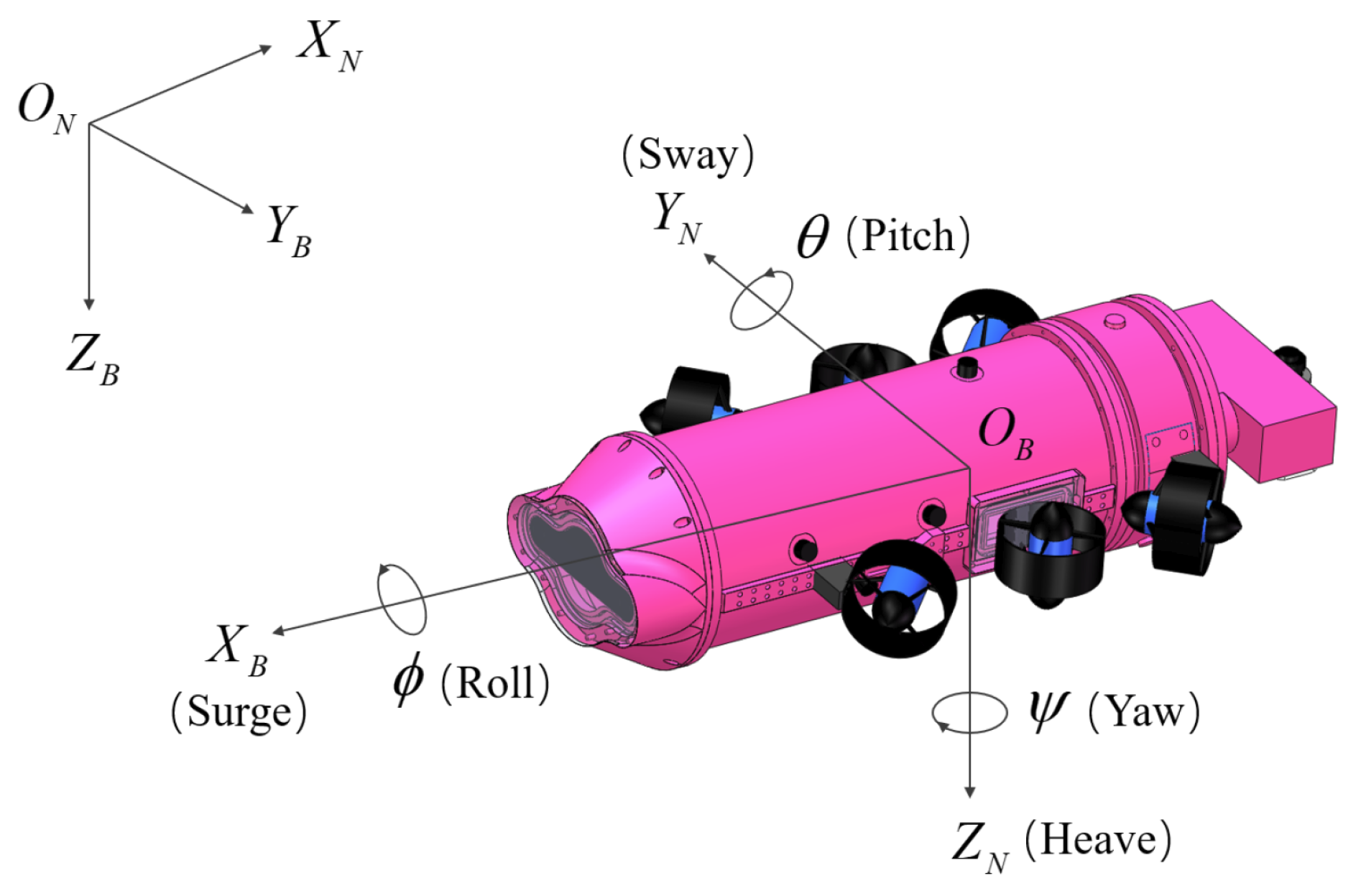
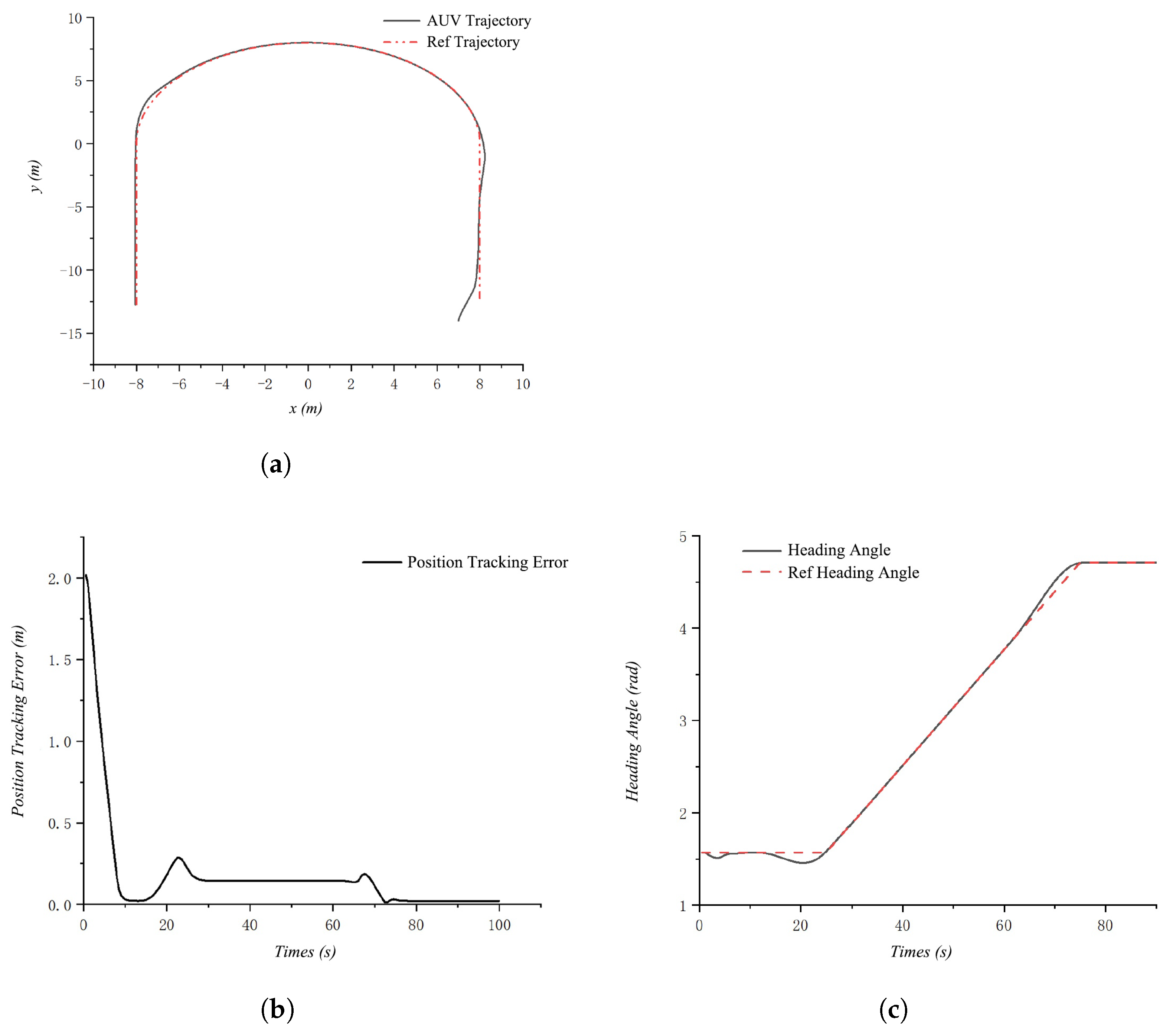
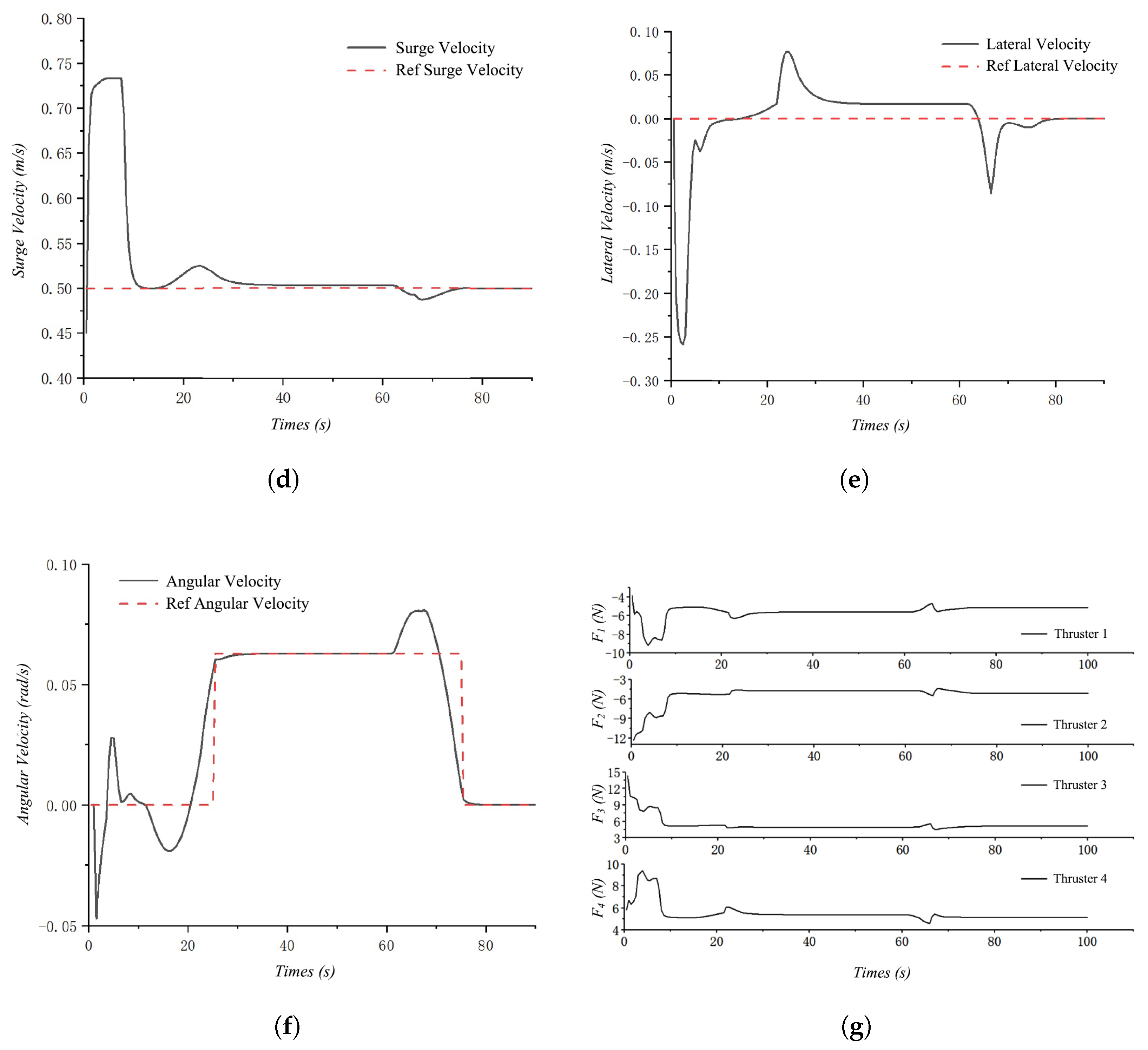

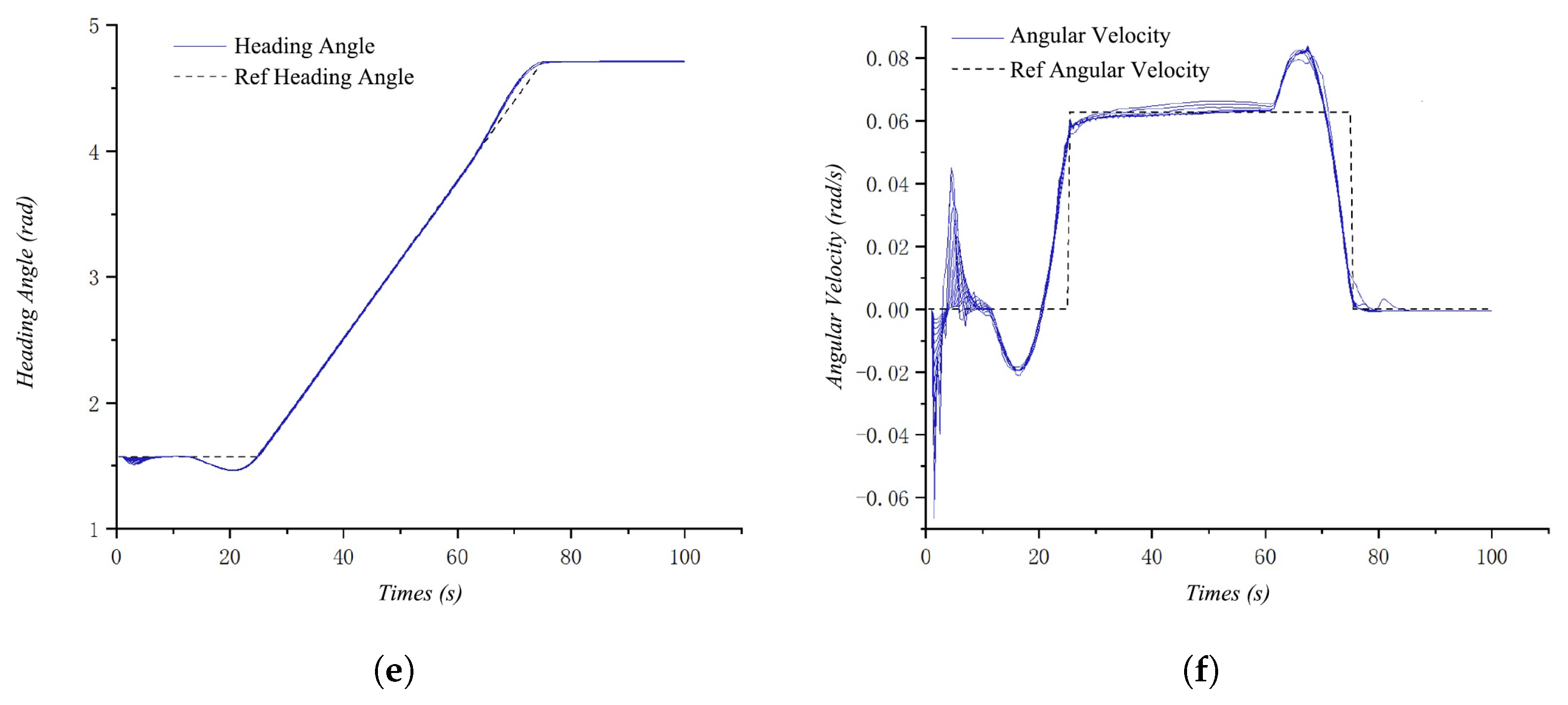
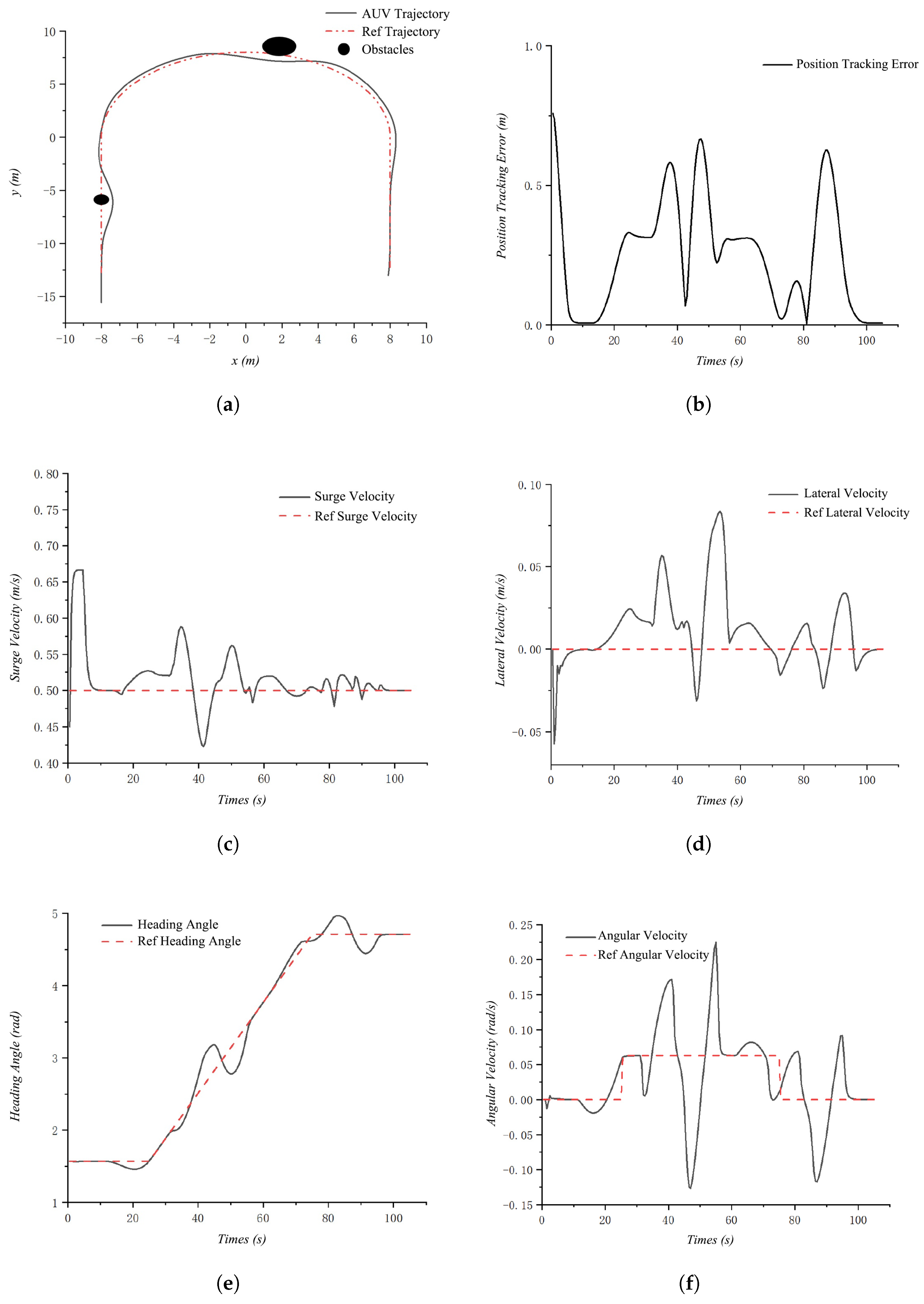
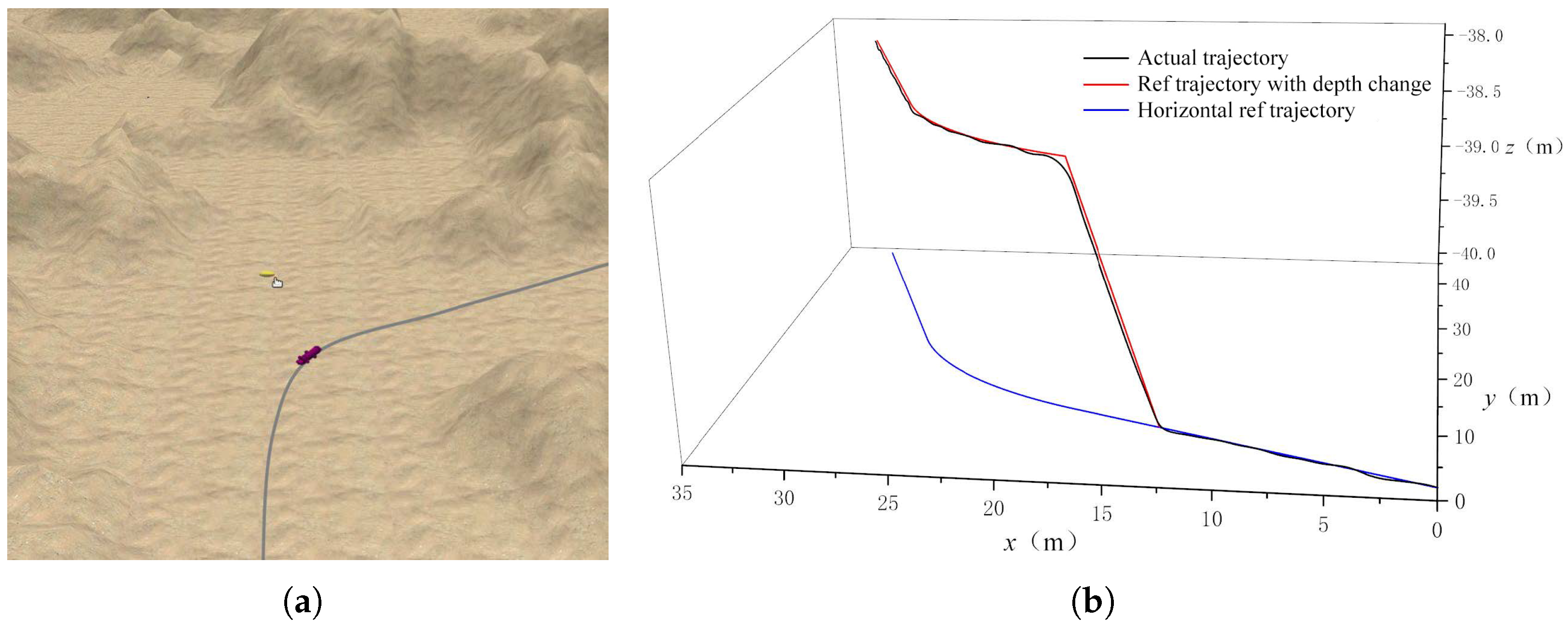

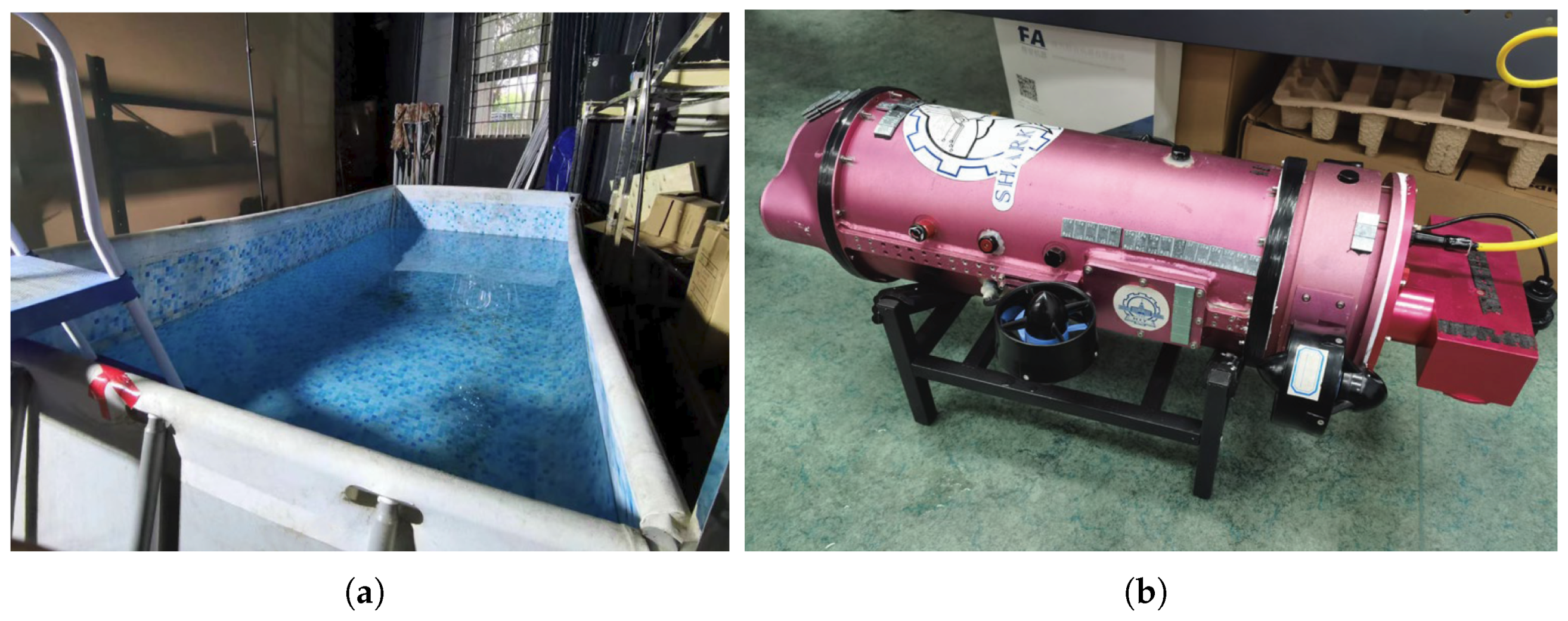
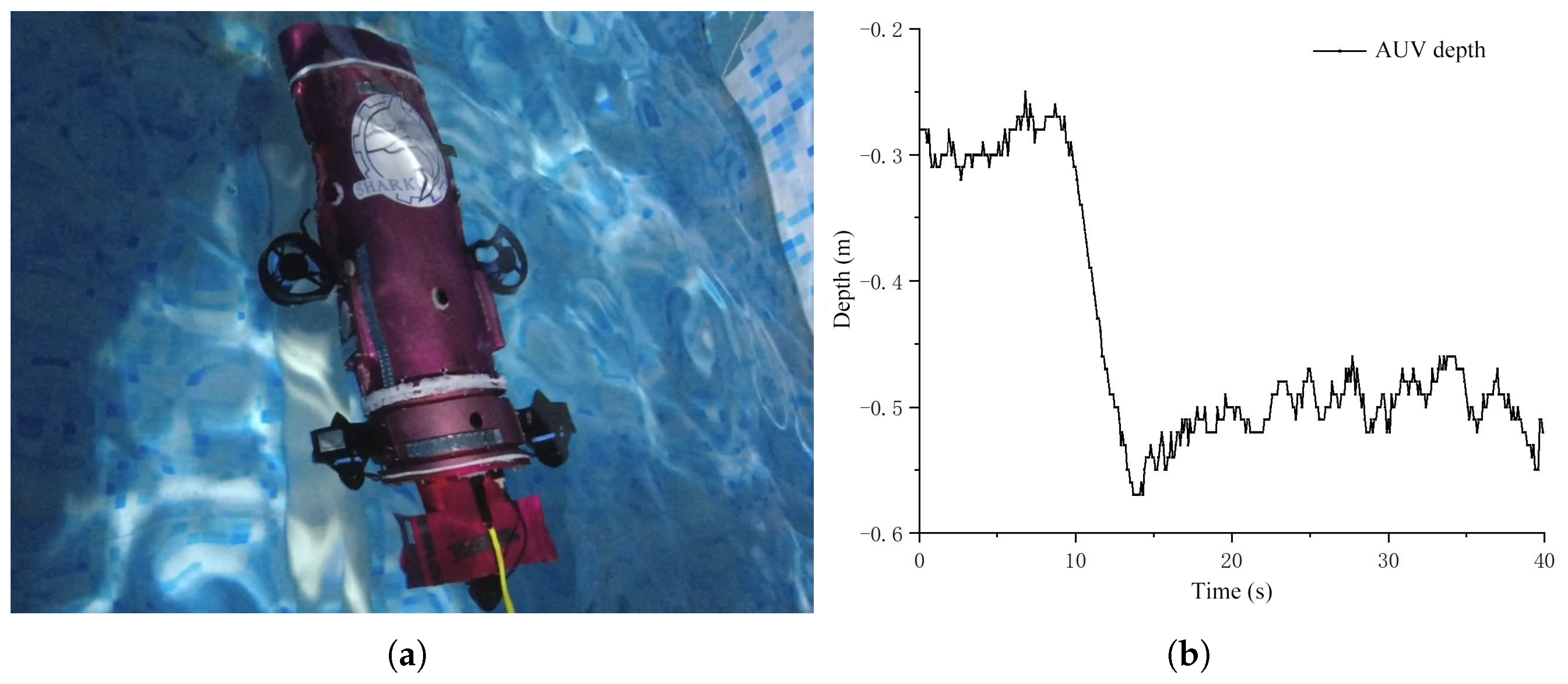
| Step | Actions |
|---|---|
| 1 | Obtain the state-space equation model of the system. |
| 2 | Use the fourth-order Runge–Kutta method to discretize the system’s state-space equations and write them in incremental form. |
| 3 | Set system constraints such as pose and velocity, input constraints such as thruster thrust. |
| 4 | Set controller parameters such as sampling interval, prediction horizon, and control horizon. |
| 5 | Define the system cost function arg min J |
| 6 | For (Control task not completed) |
| 7 | Update the parameters in the system state matrix related to the current state. |
| 8 | Under the given constraints, solve for the optimal control input sequence at the current time k to minimize the cost function. |
| 9 | Obtain the first control input from the optimal control input sequence . |
| 10 | Execute the control input within the control horizon. |
| 11 | End |
Disclaimer/Publisher’s Note: The statements, opinions and data contained in all publications are solely those of the individual author(s) and contributor(s) and not of MDPI and/or the editor(s). MDPI and/or the editor(s) disclaim responsibility for any injury to people or property resulting from any ideas, methods, instructions or products referred to in the content. |
© 2025 by the authors. Licensee MDPI, Basel, Switzerland. This article is an open access article distributed under the terms and conditions of the Creative Commons Attribution (CC BY) license (https://creativecommons.org/licenses/by/4.0/).
Share and Cite
Dai, L.; Zhang, D.; Wang, S.; Nie, G.; Zhu, X.; Wang, X. Trajectory Tracking Control of an Autonomous Underwater Vehicle Under Disturbance and Model Uncertainty. J. Mar. Sci. Eng. 2025, 13, 2210. https://doi.org/10.3390/jmse13112210
Dai L, Zhang D, Wang S, Nie G, Zhu X, Wang X. Trajectory Tracking Control of an Autonomous Underwater Vehicle Under Disturbance and Model Uncertainty. Journal of Marine Science and Engineering. 2025; 13(11):2210. https://doi.org/10.3390/jmse13112210
Chicago/Turabian StyleDai, Libo, Desheng Zhang, Songhui Wang, Guoping Nie, Xiaoyu Zhu, and Xin Wang. 2025. "Trajectory Tracking Control of an Autonomous Underwater Vehicle Under Disturbance and Model Uncertainty" Journal of Marine Science and Engineering 13, no. 11: 2210. https://doi.org/10.3390/jmse13112210
APA StyleDai, L., Zhang, D., Wang, S., Nie, G., Zhu, X., & Wang, X. (2025). Trajectory Tracking Control of an Autonomous Underwater Vehicle Under Disturbance and Model Uncertainty. Journal of Marine Science and Engineering, 13(11), 2210. https://doi.org/10.3390/jmse13112210







